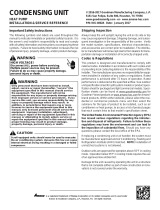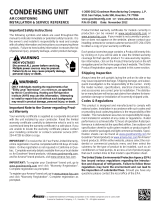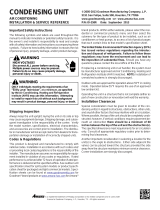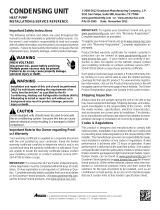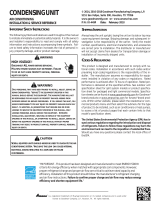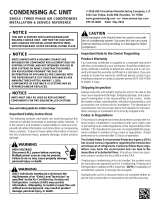Page is loading ...

INSTALLATION & OPERATING
INSTRUCTIONS for
SPLIT SYSTEM
CONDENSING UNITS
All information contained herein is subject to change without notice.
Goodman Manufacturing Company, L.P.
I0-101G 2550 North Loop West, Suite 400, Houston, TX 77092 06/04
www.goodmanmfg.com
© 2003-2004 Goodman Manufacturing Company, L.P.

2
IO-101G 06/04
INDEX
Important Message to Homeowner ...................... 2
Codes and Regulations ....................................... 2
Inspection ............................................................ 2
Replacement Parts .............................................. 2
Important Safety Instructions ............................... 2
Clearances and Accessibility ............................... 2
Location............................................................... 3
Electrical.............................................................. 3
Refrigerant Tubing ............................................... 4
Evaporator Coils .................................................. 4
Quick Connect Coils ............................................ 4
System Start Up .................................................. 4
Processing Checks.............................................. 4
Charge Checks.................................................... 5
Superheat Determination..................................... 5
Expansion Valve System ..................................... 5
Wiring Diagrams .................................................. 6
IMPORTANT MESSAGE TO OWNER
These instructions should be carefully read and kept near
product, for future reference. While these instructions are
addressed primarily to the installer, useful maintenance
information is included. Have your installing dealer
acquaint you with the operating characteristics of the
product and periodic maintenance requirements.
CODES AND REGULATIONS
This product is designed and manufactured to permit
installation in accordance with National Codes. It is the
installers responsibility to install the product in accordance
with National Codes and/or prevailing local codes and
regulations. The manufacturer assumes no responsibility
for equipment installed in violation of any code or
regulations.
Important: The United States Environmental Protection
Agency (EPA) has issued various regulations regarding
the introduction and disposal of refrigerants in this unit.
Failure to follow these regulations may harm the
environment and can lead to the imposition of
substantial fines. Because regulations may vary due
to passage of new laws, we suggest a certified
technician perform any work done on this unit. Should
you have any questions please contact the local office
of the EPA.
INSPECTION
Upon receiving the unit, inspect it for damage from
shipment. Claims for damage, either shipping or
concealed, should be filed immediately with the shipping
company. Check the unit model number, specifications,
electrical characteristics and accessories to determine if
they are correct. In the event an incorrect unit is shipped,
it must be returned to the supplier and must NOT be
installed. The manufacturer assumes no responsibility for
installation of incorrectly shipped units.
REPLACEMENT PARTS
Order all replacement parts through your local distributor.
When ordering parts, give complete model and serial
number as shown on the unit’s rating plate. Replacement
parts for this appliance are available through your
contractor or local distributor. For the location of your
nearest distributor consult the white business pages, the
yellow page section of the local telephone book or contact:
SERVICE PARTS DEPARTMENT
GOODMAN MANUFACTURING COMPANY, L.P.
2550 NORTH LOOP WEST, SUITE 400
HOUSTON, TEXAS 77092
(713) 861 – 2500
IMPORTANT SAFETY INSTRUCTIONS
Recognize Safety Symbols, Words, and Labels
The following symbols and labels are used throughout this
manual to indicate immediate or potential hazards. It is
the owner’s and installer’s responsibility to read and
comply with all safety information and instructions
accompanying these symbols. Failure to heed safety
information increases the risk of property damage and/or
product damage, serious personal injury or death.
DANGER
IMMEDIATE HAZARDS WHICH WILL RESULT IN
PROPERTY DAMAGE, PRODUCT DAMAGE, SEVERE
PERSONAL INJURY AND/OR DEATH.
WARNING
HAZARDS OR UNSAFE PRACTICES COULD RESULT
IN PROPERTY DAMAGE, PRODUCT DAMAGE,
SEVERE PERSONAL INJURY AND/OR DEATH.
CAUTION
HAZARDS OR UNSAFE PRACTICES WHICH MAY
RESULT IN PROPERTY DAMAGE, PRODUCT
DAMAGE, AND/OR PERSONAL INJURY.
CLEARANCES AND ACCESSIBILITY
The condensing unit is designed to be located outside the
building with unobstructed condenser air inlet and
discharge. Additionally, the unit must be situated to permit
access for service and installation. Condenser air enters
from three sides. Air discharges upward from the top of
the unit. Refrigerant tube electrical connections are made
on the right side of the unit as you face the compressor
compartment. The best and most common application is
for the unit to be located 10” from the back wall with the
connection side facing the wall. Refer to Figures 1 and 2.

3
IO-101G 06/04
This “close to the wall” application minimizes exposed
tubing and wiring and reduces the space for children to
run around the unit. This will help to avoid possible
damage to the tubes or wiring and/or personal injury.
Service Access
18" Min.
Service Access
18" Min.
10" Min.
10" Min.
10"
10"
FIGURE 1
Service Access
18" Min.
10" Min.
Service Access
18" Min.
10" Min.
10" .
10" .
FIGURE 2
Close to the wall application assures free, unobstructed
air to the other two sides. In more confined application
spaces, such as corners, provide a minimum 10” clearance
on all air inlet sides. Allow 18” minimum for service access
to the compressor compartment and controls.
The top of the unit should be completely unobstructed. If
units are to be located under an overhang, there should
be a minimum of 36” clearance and provisions made to
deflect the warm discharge air out from the overhang.
LOCATION
If unit is to be located under an overhang, there should be
a minimum of 36” clearance and provisions made to deflect
the water discharge air out from the overhang. If the
outdoor unit is mounted above the air handler, the
maximum lift should not exceed 70’ (suction line). If air
handler is mounted above condensing unit, the lift should
not exceed 50’ (liquid line.). Refer to Figure 3 and Table 1
for maximum refrigerant line lenghts.
PITCH SUCTION LINE TOWARD OUTDOOR
UNIT 1/2" FOR EVERY 10' OF LINE
INDOOR UNIT ABOVE OR
LEVEL TO OUTDOOR UNIT
INDOOR UNIT
LIQUID LINE
OUTDOOR UNIT
OUTDOOR UNIT
INDOOR UNIT
70' MAX.
LIQUID LINE
SUCTION LINE OIL TRAPS
WHEN INDOOR UNIT IS 4
FEET OR MORE BELOW
OUTDOOR UNIT
INDOOR UNIT BELOW
OUTDOOR UNIT
OUTDOOR UNIT
ADDITIONAL SUCTION LINE OIL TRAP
FOR EACH 20' RISE OF PIPE
INDOOR UNIT
50' MAX.
8'
SUCTION LINE
INVERTED LOOP
LIQUID LINE
FIGURE 3
Cond
Unit
Tons Suct Liq Suct Liq Suct Liq
1 1/2 5/8 1/4 3/4 3/8 3/4 3/8
2 3/4 3/8 3/4 3/8 3/4 3/8
2 1/2 3/4 3/8 3/4* 3/8 7/8 1/2
3 3/4 3/8 3/4** 3/8 7/8 1/2
3 1/2 3/4 3/8 7/8*** 3/8 1 1/8 1/2
4 7/8 3/8 1 1/8 3/8 1 1/8 1/2
5 7/8 3/8 1 1/8 3/8 1 1/8 1/2
Line Diameter (In. OD)
REFRIGERANT LINE LENGTH (Ft)
0-24 25-49 50-74***
* 7/8" required for full ratings
** 1 1/8" required for full ratings
TABLE 1
The condensing unit must be mounted on a solid, level
foundation, i.e. pre-formed concrete slab or other suitable
base. For rooftop application, make sure the building
construction can support the weight and that proper

4
IO-101G 06/04
consideration is given the weather-tight integrity of the roof.
The condensing unit contains moving components and can
vibrate; therefore, sound is also a consideration in rooftop
application. Since this unit discharges warm condenser
air from the top with cooler air being drawn in three sides,
plantings can be made in relatively close proximity to the
unit. Owners should be advised to avoid lawn mower
discharge toward the unit depositing debris on the fan coil
surface reducing product efficiency.
ELECTRICAL
Electrical installation will consist of power supply wiring to
the condensing unit as well as control wiring between
thermostat, indoor unit and the condensing unit as shown
on wiring diagram. All wiring must be in accordance with
National Electrical Code and/or local codes that may apply.
The condensing unit rating plate and the table inside the
front cover of this instruction lists pertinent electrical data
necessary for the selection of proper size electrical service
and over-current protection. The owner should be made
familiar with the location of the over-current protection,
the proper size for this application and the proper
procedure for disconnecting power service to the unit.
The condensing unit control wiring requires a 24 Volt
minimum 25 VA service from the indoor transformer as
shown on the wiring diagram.
REFRIGERANT TUBING
Use only refrigerant grade (dehydrated and sealed) copper
tubing of the size indicated in Table 1 to interconnect the
condensing unit with the indoor evaporator. Take extreme
care to keep the refrigerant tubing clean and dry prior to
and during installation.
Do not remove plugs from ends of tubing until connection
is ready to be made. Suction line insulation is necessary
to prevent condensation from forming on and dropping
from suction line. Generally 3/8" wall thickness of Armflex
or equivalent is satisfactory. In severe application (hot, high
humidity areas) greater thickness may be required. Apply
suction line insulation by sliding it on the sealed tubing
before cutting and making connections.
EVAPORATOR COILS
WARNING
USE EXTREME CARE IN REMOVING THE CAPS
FROM THE SUCTION AND LIQUID LINE FITTINGS
AS THERE IS PRESSURE PRESENT. A FITTING IS
ON THE LIQUID LINE TO REMOVE PRESSURE.
WARNING
DO NOT REMOVE PROTECTIVE CAPS UNTIL
INSTALLATION HAS BEEN COMPLETED AND FINAL
CONNECTIONS ARE TO BE MADE.
Field Connection to the Valve and Valve Opening
1. Tubing should be cut square. Make sure it is round
and free of burrs at the connecting ends. Clean the
tubing to prevent contaminants from entering the
system.
2. Wrap a wet rag around the copper valve stub before
brazing.
3. Braze or silver solder the joint.
4. After brazing, quench with a wet rag to cool the joint.
Evacuate and charge the connecting lines as outlined
in these instructions.
5. Remove valve top cap. It is important to keep the cap
in a clean area to assure proper sealing once replaced.
6. Using a standard L shaped Allen wrench, break open
the valve body. To expedite opening the valve body
after it is broken, use a ratchet wrench with a short
Allen stub. Please note that it is normal to see oil on
the valve stem body once the cap is removed.
7. Replace the valve cap and tighten with a wrench
making sure that the the cap is sealed.
QUICK CONNECT COILS
Precharged System Installation
Installation procedure will differ when condensing units
are provided for use with precharged refrigerant coils and
lines. Condensing units are provided with #6 and #11
male quick connects instead of liquid and suction valves
attached to cabinet to contain the R-22 charge that is
sufficient for matching evaporator coils and 15’ of
interconnecting lines.
Coils are provided with #6 and #11 male quick connects.
Line sets are required with #6 and #11 female quick
connects on both ends. Access ports are required in the
fittings of both liquid and suction lines at condenser end.
Both coil and line sets include R-22 holding charge only.
1. Connect lines to evaporator coil before connecting to
the condensing unit locating access ports adjacent to
condensing unit.
a. Form tubing so it properly aligns with the coil
connections.
b. Remove plugs and caps from connections.
c. Check to be sure mating surfaces are clean.
d. Lubricate rubber seal with clean refrigerant oil and
thread couplings together by hand to be sure they are
not cross threaded.
e. Tighten connections using backup wrench on
stationary fitting until coupling bottoms; then tighten
1/6 turn to complete knife edge seal.
2. Connect lines to condensing unit in the same manner
as to evaporator coil. Observe same precautions.
3. After making all connections and opening valves,
check all piping for leaks.
SYSTEM START UP
Processing Checks
Condensing units are supplied R-22 charge sufficient for
typical matching evaporator and approximately 15’ of
interconnecting tubing. Condensing unit liquid and suction
valves are closed to contain the charge within the unit.

5
IO-101G 06/04
The recommended procedure for processing and charge
adjustment is as follows:
1. Connect vacuum pump to both base valve service
ports.
2. Evacuate tubing and evaporator through liquid and
suction base valve ports, to 500 microns or less for a
minimum of 30 minutes. Close valve to pump and
wait 15 minutes. Vacuum should not rise above 800
microns. If unable to obtain 500 micorns, or vacuum
rises above 800 microns over a 15 minute period,
discontinue evacuation, pressurize and check for
leaks. Repair any leaks found and repeat step 2.
3. Close valve to vacuum pump and stop pump. Break
vacuum by opening liquid and suction base valves.
Fully open base valves and remove pump lines.
Connect service gauges making sure lines are purged.
4. Set thermostat system switch to “COOL” and
temperature to highest setting. Close all disconnects.
5. Set thermostat to call for cooling. Check for operation
of indoor and outdoor fans. Allow for at least 10
minutes.
6. Check charge and adjust if necessary. Refer to
appropriate “Check Charge” section.
Charge Checks
Capillary Tube/Fixed Orifice System
1. Fully open both base valves.
2. Connect service gauge manifold to base-valve service
ports being sure to purge lines. Run system at least
10 minutes to allow pressure to stabilize.
3. Temporarily install thermometer on suction (large) line
near condensing unit. Be sure of good contact
between the thermometer and line. Wrap thermometer
with insulating material to assure accurate reading.
4. Refer to Table 2 for proper system superheat. Add
charge to lower superheat. Remove charge to raise
superheat.
5. Remove gauge lines carefully.
WARNING
ESCAPING LIQUID REFRIGERANT CAN CAUSE
BURNS.
AMBIENT CONDENSER
INLET TEMPERATURE
°F DRYBULB 65 70 75 80 85
100 5 5
95 5 5 5
90 7 12 18
85 5 10 17 20
80 5 12 21 26
75 5 10 17 25 29
70 5 14 20 28 32
65 13 19 26 32 35
60 17 25 30 33 37
RETURN AIR TEMPERATURE
( °F DRYBULB)
SYSTEM SUPERHEAT
TABLE 2
Superheat Determination
1. Read suction pressure. Using Table 3, determine
saturated suction temperature.
2. Read suction line temperature.
3. Use the following formula to determine superheat:
Superheat = Suction Line Temp. - Saturated Suction Temp.
SUCTION SATURATED SUCTION
PRESSURE PSIG TEMPERATURE °F
50 26
53 28
55 30
58 32
61 34
63 36
66 38
69 40
72 42
75 44
78 46
81 48
SATURATED SUCTION PRESSURE (R-22)
TABLE 3
Expansion Valve System
1. Fully open both base valves.
2. Connect service gauge manifold to base-valve service
parts making sure lines are purged. Run system at
least 10 minutes to allow pressure to stabalize.
3. Temporarily install the thermometer to liquid (small)
line near condensing unit. Be sure that the contact
between thermometer and line is good. Wrap
thermometer with insulating material to ensure
accurate reading.
4. Referring to Table 4, adjust charge to obtain a
temperature 12-15°F below the saturated liquid
temperature.
Example:
If the Liquid Pressure is 260 PSIG then the Saturated
Temperature will be 120°F. Adjust the Saturated
Temperature by subtracting 12-15°F. This will give you a
Liquid Line Temperature of 105° - 108°F.
LIQUID PRESSURE SATURATED
(PSIG) TEMPERATURE °F
200 102
210 105
220 108
230 111
240 114
250 117
260 120
270 123
280 126
290 128
300 131
SATURATED LIQUID TEMPERATURE
TABLE 4

6
IO-101G 06/04
SPECIAL NOTE: Systems with MORE than 15’ of
interconnecting tubing, please refer to Table 5 for line
charge allowance per foot of tubing.
LINE LIQUID SUCTION
O. D. (IN) LINE LINE
1/4 0.22
3/8 0.58
1/2
1.14
5/8 1.86 0.04
3/4 0.06
7/8 0.08
1 1/8 0.15
1 3/8 0.22
LINE CHARGE ALLOWANCE (R-22) (oz./ft.)
TABLE 5
NOTE: System with over 50’ separation between
condensing unit and evaporator may require oil charge
adjustment.
1 - 1 1/2
2 - 5
UNIT MODEL
(TONS)
0.5
ADDITIONAL OIL CHARGE PER EACH
ADDITIONAL 10' OF LINE (OZ.)*
0.25
OIL CHARGE ADJUSTMENT
*Use either Texaco WF-32 (formerly cappella B)
or Suniso 3G-S oil
TABLE 6

7
IO-101G 06/04
CONTROLS SHOWN WITH UTILITIES IN 'ON'POSITION
LOW VOLTAGE DEFROST RELAY
OUTDOOR THERMOSTAT (OPTIONAL)
HIGH VOLTAGE DEFROST RELAY
AND THERMOSTAT IN 'OFF' POSITION.
REVERSING VALVE COIL
FAN CAPACITOR
HIGH PRESSURE CONTROL
CRANKCASE HEATER
INTERNAL OVERLOAD
LOW PRESSURE CONTROL
DEFROST THERMOSTAT
COMPONENT CODE
OUTDOOR FAN MOTOR
DEFROST CONTROL
COMPRESSOR
CONTACTOR
CONNECT TO APPROP. CONTROL CIRCUIT HAVING
LIMITED CLASS 2 TRANSFORMER.
INSTALLATION. USE C.S.A. CERTIFIED ENERGY
TRAMSFORMER OR FOR CERTIFIED C.S.A
MIN. 40 VA. 24 VOLT N.E.C. CALSS 2
WIRING CODE
COPPER CONDUCTORS ONLY
EQUIPMENT GROUND USE
R
LIGHT BLUE
USE N.E.C. CLASS 2 WIRE
G GREEN
W
O ORANGE
WHITE
V
BR
LTBL
BL
R
Y
VIOLET
BROWN
YELLOW
BLUE
RED
COLOR CODE
BK BLACK
V
R
CM
AUX
MAIN
IO
BK
BR
V
POWER SUPPLY
(SEE RATING PLATE)
USE COPPER CONDUCTORS ONLY
FC
BR
DC
BK
CH
BK
COMP
C
BK
R
S
RVC
HVDR
LDVR
CH
IO
HP
OT
LP
FC
DFT
Y
BK
BK
COMP
C
CM
LOW VOLTAGE
HIGH VOLTAGE
FACTORY WIRING
T3
L3
R
L1
C
L2
T1
BL
T2
BK
R
Y
BK
Y
BR
V
Y
HP
1) TO INDOOR UNIT LOW
2) SEE INDOOR UNIT &
INDOOR THERMOSTAT.
OF OPTIONAL OUTDOOR THERMOSTAT.
INSTRUCTIONS FOR CONNECTION
OUTDOOR UNIT INSTALLATION
VOLTAGE TERMINAL BLOCK &
INDOOR POWER SUPPLY
NOTES:
FIELD WIRING
R
ADJ. HEAT
ANTICIPATOR
THERMOSTAT
BULB
THERMOSTAT
R
COOL
THERMOSTAT
ANTICIPATOR
B17783-00
07/97 REV. D
24V
TRANSFORMER
HEAT
W
COIL
SYSTEM
SWITCH
THERMOSTAT
OFF
COOL
COIL
FAN RELAY
COIL
C
CH
THERMOSTAT
FAN SWITCH
HP
3
COMP
2
C
T3
L3
C
T2
L2
MOTOR
AUTO
ON
G
CONTACTOR
1
CAP
C
T1
L1
OUTDOOR POWER SUPPLY
Y
LINE SPLICE
WIRE NUT
C
T1
L1
BL
V
V
LOW VOLTAGE
BK
ANTICIPATOR
THERMOSTAT
BULB
THERMOSTAT
ADJ. HEAT
THERMOSTAT
ANTICIPATOR
HIGH VOLTAGE
LOW VOLTAGE
OPTIONAL START ASSIST
WIRE NUT
REPLACEMENT WIRE MUST BE SAME
GAGE AND INSULATION THICKNESS,
105° C APPLIANCE WIRING MATERIAL.
NOTES:
CRANKCASE HEATER IF USED
WIRING CODE
BK
WIRING
FACTORY
FIELD
WIRING
WIRING FOR
FACTORY
OPTIONS
G
BR
LTBL
LIGHT BLUE
GREEN
BROWN
R
COLOR CODE
PU
Y
BL
R
BK
YELLOW
PURPLE
BLUE
RED
BLACK
R
B17784-01
W
24V
INDOOR POWER SUPPLY
3/98 REV. A
LOW VOLTAGE
TRANSFORMER
COOL
OFF
HEAT
COOL
THERMOSTAT
SYSTEM
SWITCH
COIL
FAN RELAY
Y
COIL
C
THERMOSTAT
FAN SWITCH
Y
(START ASSIST
START ASSIST
OUTDOOR CONTROL BOX
COMPRESSOR/FAN
R
BR
R
R
BK
SC
COMPRESSOR
Y
BK
PU
PU
FAN MOTOR
IF USED)
Y
CAPACITOR
HERM
F
C
T2
BK
BK
Y
R
PU
PU
L1
T1
TRANSFORMER OR FOR
MIN. 40 VA 24 VOLT
CONTROL CIRCUIT HAVING
INSTALLATION. USE C.S.A.
CERTIFIED ENERGY LIMITED
CLASS 2 TRANSFORMER.
CERTIFIED C.S.A.
N.E.C. CLASS 2
CONNECT TO APPROP.
OUTDOOR POWER
SUPPLY - (SEE
UNIT RATING
USE COPPER
CONDUCTORS ONLY
GROUNDED SUPPLY
NEUTRAL OR
EQUIPMENT GROUND
USE L1 FOR
IF USED
L2
T2
PLATE)
R
Y
R
BR
PU
BK
BK
ALT. DOUBLE
POLE CONTACTOR
R
R
L1
T1
L2
T2
T
O
T
A
C
O
N
L2
C
T1
C
CONTACTOR
CAPACITOR
AUTO
ON
G
COIL
COMPRESSOR
INTERNAL
OVERLOAD
START ASSIST
(IF USED)
MOTOR
S
FAN MOTOR
R
OUTDOOR POWER SUPPLY
CRANKCASE HEATER
COMPRESSOR
R
(IF USED)
T
T
O
C
A
L1
O
N
C
SINGLE PHASE
THREE PHASE
WIRING DIAGRAMS

8
IO-101G 06/04
NOTE: SPECIFICATIONS AND PERFORMANCE DATA LISTED HEREIN
ARE SUBJECT TO CHANGE WITHOUT NOTICE
Quality Makes the Difference!
All of our systems are designed and manufactured with the same high quality standards regardless of size or
efficiency. We have designed these units to significantly reduce the most frequent causes of product failure.
They are simple to service and forgiving to operate. We use quality materials and components. Finally, every
unit is run tested before it leaves the factory. That’s why we know. . .There’s No Better Quality.
Visit our website at www.goodmanmfg.com for information on:
• Goodman products
• Warranties
• Customer Services
• Parts
• Contractor Programs and Training
• Financing Options
© 2003-2004 Goodman Manufacturing Company, L.P.
/


